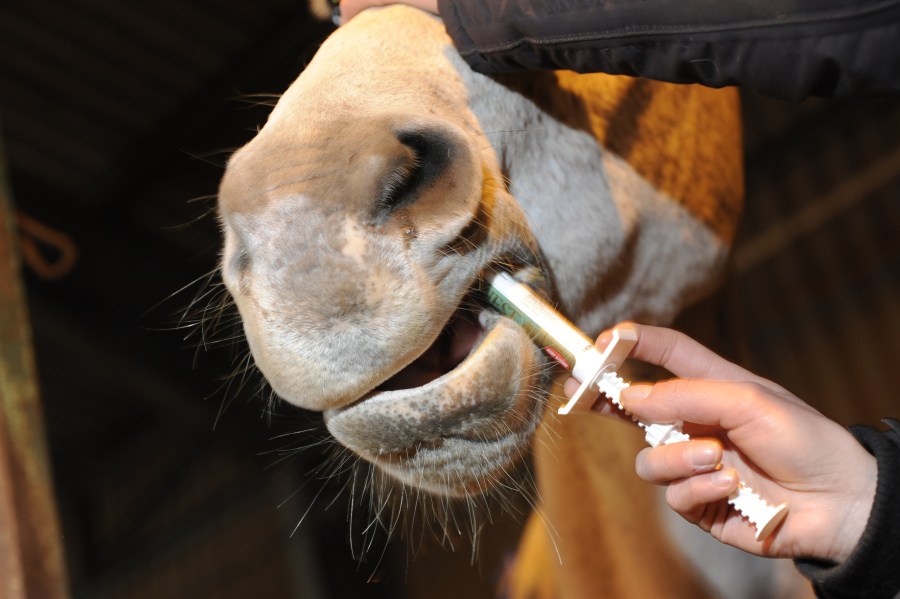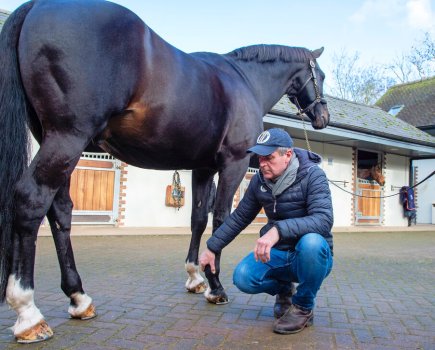There are three main types of winter worms that affect horses at this time of year, and so it is important to factor in worming when taking care of a horse in the winter. Worm burdens in horses are capable of causing lots of health concerns, so it’s important to understand the different worms and the damage they can cause, as well as how to test and treat them.
According to vet Sue Taylor MRCVS, the three main types of horse winter worms that require testing for (and treating if necessary) are encysted small redworm, tapeworm and bots. Find out more about each worm and the action you should take below.
Tapeworm (Cestodes)
Tapeworms are grey, flat, segmented worms that can grow up to 8cm long and 1.5cm wide. They form clusters at the junction between the small and large intestines where the mature worm releases segments full of eggs. These are then passed in the horse’s droppings onto the pasture. Here, they are eaten by the forage mite, the eggs hatch and the larvae develop inside the mite. The horse then eats the mite while grazing and the larvae develops into a mature adult over the next six to ten weeks. This is why regular poo-picking is an essential part of your worming regime.
Damage: Once inside the horse, tapeworm can cause digestive issues, loss of condition, spasmodic colic and fatal blockages.
Treatment: Tapeworms won’t show up in a faecal worm egg count, but there is a blood test available and a saliva test that owners can do themselves. This should be done once in the spring and once in the autumn to detect whether your horse has a tapeworm burden and requires treatment.
Testing: Tapeworm burdens are likely to be highest in autumn, at the end of the grazing season, so testing — and worming only if necessary — should take place then.
Bots (Gastrophilus)
Bot flies lay sticky yellow eggs on the horse’s coat, particularly the legs, shoulders and face in the summer, which are then ingested when the horse grooms themselves. The larvae then hatch and penetrate the mucosa of the tongue and mouth and then migrate towards the pharynx and then the stomach. Here, they attach to the stomach lining. After nine months, the large red or yellow larvae are passed in the droppings the following spring and summer. After six weeks, the adult fly emerges.
Damage: If left untreated, bots can cause inflammation in the mouth and throat, and ulceration and damage in the stomach.
Treatment: If possible, every effort should be made to remove bot fly eggs from the horse in the summer before the horse ingests them. There’s a specific tool that makes this possible as they are tricky to remove by hand alone.
Testing: There is no test for bots because they pass as larvae in the droppings and not as eggs. Administer a wormer after the first frost when the adult flies have died and before the bots mature.
Encysted small redworm (Cyathostomes)
Encysted small redworm is one of the most common and damaging parasites found in horses. The larvae hibernate in the gut wall during the winter and emerge en masse as adults in the early spring, causing severe damage to the horse’s intestines. Encysted small redworm pose a potentially fatal health risk.
Damage: Untreated, encysted small redworm may develop into adults. They can cause weight loss, diarrhoea and colic in horses with a mortality rate of up to 50%.
Treatment: It is important horse owners realise that the presence of encysted small redworm will not show up in a faecal worm egg count because the larvae do not lay eggs. It is for this reason that all horses should be treated for encysted small redworm during late autumn and winter.
Testing: For horses that have had regular worm egg counts under 200epg through the previous year, a small redworm blood test by your vet is the best way to decide if worming is required.
“For others this is one of the only times when a proactive moxidectin treatment is recommended,” states Claire Shand from Westgate Labs. “This is because out of the two chemicals licenced against larval small redworm, it is the one with least documented resistance, the alternative being fenbendazole as a five-day course. We aim to reserve moxidectin for this use in order to preserve its efficacy as a key medicine against encysted redworm.”
If you know you are going to treat then carrying out a redworm reduction test — a worm egg count before treatment and another 10 to 14 days afterwards — is advised to measure whether there is any resistance to the chemical used within the worms on your pasture.
Winter worms: the key message
Claire stresses how important it is that keeping on top of winter worms in order to keep horses healthy and prevent resistance to wormers, which is a growing problem.
“The most important [horse worm] to consider is encysted redworm, the larval stages of which have the ability to hibernate in the horse over winter, and which are a particularly dangerous threat to health,” she states. “Many thousands can burrow into the gut wall and lay dormant before staging a mass emergence in springtime. This can trigger colic that is very difficult to treat. To guard against this, we need to test or treat for worms proactively.
“Carry out a saliva test for tapeworm if this hasn’t been done in the previous six months, and consider bots if any of the small yellowish eggs of this fly have been seen on the horse’s coat over the summer months,” continues Claire. “Results from all of these tests will help to decide which, if any, treatment is needed and target this to help slow resistance. Do a worm egg count again eight to 12 weeks on.”
Love hacking? Join our free #Hack1000Miles challenge and see how far you can go!
Subscribe to Your Horse Magazine – the perfect Christmas gift!










